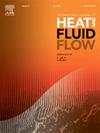Effect of pulsation intensity on flow and dispersion characteristics of single-pulsed dual parallel plane jets
IF 2.6
3区 工程技术
Q2 ENGINEERING, MECHANICAL
International Journal of Heat and Fluid Flow
Pub Date : 2024-12-03
DOI:10.1016/j.ijheatfluidflow.2024.109684
引用次数: 0
Abstract
The effect of pulsation intensity on flow and dispersion characteristics of single-pulsed dual parallel plane jets was experimentally investigated in this study. A single jet from a pair of dual jets was pulsed by a loudspeaker. The flow evolution processes were examined using the laser-light sheet-assisted smoke flow visualization method. The visual spread of the jet flow was measured using the binary boundary edge detection technique. A hotwire anemometer was used to detect the instantaneous velocities, mean velocities, turbulence intensities, Lagrangian integral time, and length scales. The dispersion capabilities of the jet fluid were evaluated employing the tracer-gas concentration detection technique. Two characteristic flow modes, namely the coherent vortices and vortex breakup, could be classified based on pulsation intensity. At Ip < 1.0, the flow was characterized by coherent vortices, which maintained coherence within one excitation cycle. At Ip > 1.0, vortex breakup occurred, where vortices deformed, lost coherence, and transformed into puff-shaped vortical structures within one excitation cycle. The vortices emerging from the pulsed jet undergo deformation, evolving into puff-shaped vortices, and subsequently fragment into smaller turbulent eddies more quickly than the synchronized vortices from the non-pulsed jet. This leads to significant penetration and velocity fluctuations in the trajectory of the pulsed jet. Consequently, the overall spread width and concentration reduction index of the single-pulsed dual parallel plane jets exceed those of the non-pulsed dual parallel plane jets.
求助全文
约1分钟内获得全文
求助全文
来源期刊

International Journal of Heat and Fluid Flow
工程技术-工程:机械
CiteScore
5.00
自引率
7.70%
发文量
131
审稿时长
33 days
期刊介绍:
The International Journal of Heat and Fluid Flow welcomes high-quality original contributions on experimental, computational, and physical aspects of convective heat transfer and fluid dynamics relevant to engineering or the environment, including multiphase and microscale flows.
Papers reporting the application of these disciplines to design and development, with emphasis on new technological fields, are also welcomed. Some of these new fields include microscale electronic and mechanical systems; medical and biological systems; and thermal and flow control in both the internal and external environment.
 求助内容:
求助内容: 应助结果提醒方式:
应助结果提醒方式:


